Text
Opallionectes andamookaensis

Photo by: Steve, https://www.deviantart.com/lizardman22/art/Opallionectes-andamookaensis-583247675
Name: Opallionectes andamookaensis
Name Meaning: Opal swimmer
First Described: 2006
Described By: Kear
Classification: Chordata, Tetrapoda, Reptilia, Sauropterygia, Plesiosauria, Plesiosauroidea
Opallionectes was a plesiosaur that lived during the Early Cretaceous of what is now known as Australia. Data suggests that this plesiosaur may have dwelled in very cold waters. Opallionectes may have had blubber as an adaptation for this freezing type of environment. Paleontologists actually found Opallionectes in an opal mine down in South Australia.
Sources:
https://en.wikipedia.org/wiki/Opallionectes
#Opallionectes#palaeoblr#paleontology#palaeontology#prehistoric#Mesozoic#ancient marine reptiles#Not a dinosaur#sauropterygia
161 notes
·
View notes
Text
Nichollssaura borealis
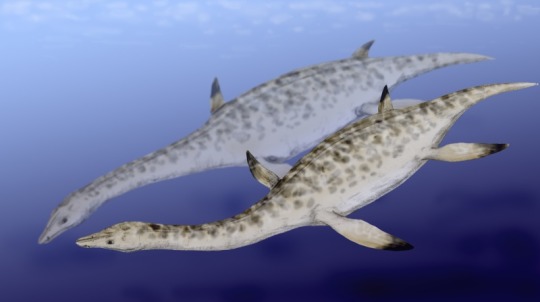
Art by: Arthur Weasley, CC BY 3.0
Name: Nichollssaura borealis
Name Meaning: Nicholls lizard
First Described: 2009
Described By: Druckenmiller and Russell
Classification: Chordata, Tetrapoda, Reptilia, Sauropterygia, Plesiosauria, Leptocleididae
This leptocleidid plesiosaur could be found lurking within the depths of the Boreal Sea during the Early Cretaceous. Nichollssaura was found in Canada, specifically near Alberta. The specimen was found well intact with the exception of the left forelimb and scapula being missing; it’s fairly complete. This plesiosaur was originally called Nichollsia, but that name was already taken by an isopod, thus Nichollssaura was born.
Sources:
https://en.wikipedia.org/wiki/Nichollssaura
#Nichollssaura#palaeoblr#paleontology#palaeontology#prehistoric#Mesozoic#ancient marine reptiles#Not a dinosaur#sauropterygia
56 notes
·
View notes
Text
Nakonanectes bradti
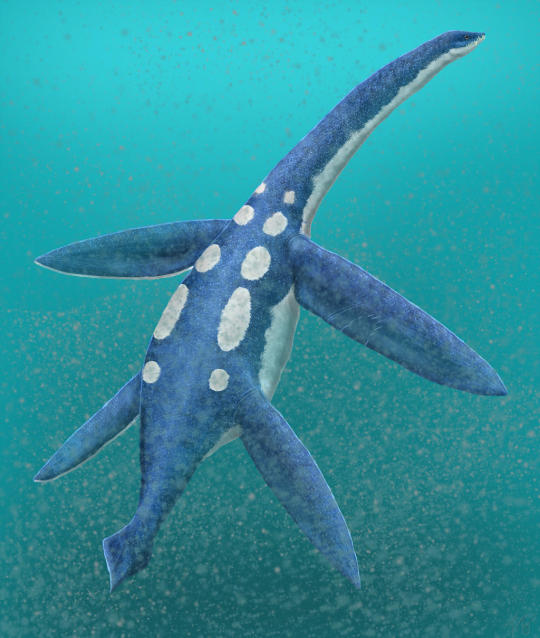
Art by: Drex, https://www.deviantart.com/spinozillarex/art/nakonanectes-761449910
Name: Nakonanectes bradti
Name Meaning: Nakona swimmer
First Described: 2017
Described By: Serratos et al.,
Classification: Chordata, Tetrapoda, Reptilia, Sauropterygia, Plesiosauria, Elasmosauridae
Nakonanectes was an elasmosaurid that had a pretty short neck, but it’s actually one of the earlier known elasmosaurs from North America. Nakonanectes was discovered in Montana and it swam the waters of the Western Interior Seaway. We have a pretty well preserved skull, back vertebrae, partial limbs, ribs, and unsurprisingly gastroliths were also recovered. It was estimated to have been 17-18 feet (5.1 to 5.6 meters) in length. For an elasmosaurid, Nakonanectes was on the smaller side.
#Nakonanectes#palaeoblr#paleontology#palaeontology#prehistoric#Mesozoic#ancient marine reptiles#Not a dinosaur#sauropterygia
63 notes
·
View notes
Text
Muiscasaurus catheti
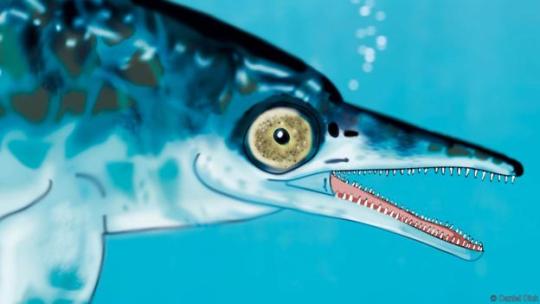
Art by: Daniel Dick
Name: Muiscasaurus catheti
Name Meaning: Muisca lizard
First Described: 2015
Described By: Maxwell et al.,
Classification: Chordata, Tetrapoda, Reptilia, Ichthyosauria, Ophthalmosauridae
We have another marine reptile from the Paja Formation in Colombia. Muiscasaurus was a Late Cretaceous ophthalmosaurid, we have uncovered part of its skull, some ribs, and vertebrae. Muiscasaurus had four nostrils, two openings on each side of its snout. Muiscasaurus probably consumed prey that were soft and small.
Sources:
https://en.wikipedia.org/wiki/Muiscasaurus
#Muiscasaurus#palaeoblr#paleontology#palaeontology#prehistoric#Mesozoic#ancient marine reptiles#Not a dinosaur#ichthyopterygia
51 notes
·
View notes
Text
Morturneria seymourensis
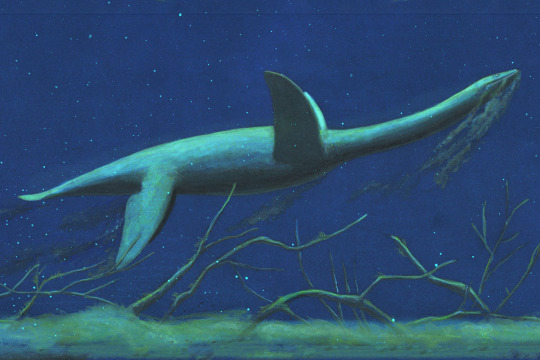
Art by: Joschua Knüppe
Name: Morturneria seymourensis
Name Meaning: In honor of Mort D. Turner and the original proposed name of Turneria
First Described: 1994
Described By: Chatterjee and Creisler
Classification: Chordata, Tetrapoda, Reptilia, Sauropterygia, Plesiosauria, Elasmosauridae
Morturneria lived during the Late Cretaceous, and was discovered in Antarctica. What’s really fascinating is that Morturneria was a filter feeding plesiosaur, using its mouth as a sieve to indulge in marine invertebrates. The filter feeding strategy may have evolved in order to avoid direct competition with its other marine reptiles. Morturneria was once thought to be a juvenile Aristonectes, but paleontologists saw differences in non-ontological characteristics in Morturneria, thus distinguished it from Aristonectes. Fun fact, Morturneria was originally named Turneria, but the name was already taken by a genus of ant.
Sources:
https://en.wikipedia.org/wiki/Morturneria
#Morturneria#palaeoblr#paleontology#palaeontology#prehistoric#Mesozoic#ancient marine reptiles#Not a dinosaur#sauropterygia
84 notes
·
View notes
Text
Megalneusaurus rex

Art by: Dmitry Bogdanov, Public Domain
Name: Megalneusaurus rex
Name Meaning: Great swimming lizard king
First Described: 1895
Described By: Knight
Classification: Chordata, Tetrapoda, Reptilia, Sauropterygia, Plesiosauria, Pliosauroidea
Megalneusaurus swam the Sundance Sea during the Late Jurassic. We have its vertebrae, ribs, and portions of the front flipper. It is hypothesized that Megalneusaurus could have grown to a size similar to that of Liopleurodon, see my previous post on that. Megalneusaurus probably ate other marine reptiles or whatever it could take down.
Sources:
https://en.wikipedia.org/wiki/Megalneusaurus
#Megalneusaurus#palaeoblr#paleontology#palaeontology#prehistoric#Mesozoic#ancient marine reptiles#Not a dinosaur#sauropterygia
101 notes
·
View notes
Text
Megacephalosaurus eulerti

Art by: James Kuether, https://www.deviantart.com/paleoguy/art/Megacephalosaurus-680915036
Name: Megacephalosaurus eulerti
Name Meaning: Large head lizard
First Described: 2013
Described By: Schumacher et al.,
Classification: Chordata, Tetrapoda, Reptilia, Sauropterygia, Plesiosauria, Pliosauridae
Megacephalosaurus was a Late Cretaceous pliosaur. It was discovered in the Carlile Shale Formation in Kansas. Megacephalosaurus actually represents one of the last members of the pliosauridae family.
Sources:
https://en.wikipedia.org/wiki/Megacephalosaurus
#Megacephalosaurus#palaeoblr#paleontology#palaeontology#prehistoric#Mesozoic#ancient marine reptiles#Not a dinosaur#sauropterygia
74 notes
·
View notes
Text
Mauriciosaurus fernandezi

Art by: Nobu Tamura, CC BY-SA 4.0
Name: Mauriciosaurus fernandezi
Name Meaning: Mauricio’s reptile
First Described: 2017
Described By: Frey et al.,
Classification: Chordata, Tetrapoda, Reptilia, Sauropterygia, Plesiosauria, Polycotylidae
Mauriciosaurus was a polycotylid plesiosaur that lived during the Late Cretaceous of what is now known as Mexico. We have a pretty well preserved juvenile specimen that was found in an area with lack of oxygen. The lack of oxygen is actually what helped preserve the soft tissues found within this plesiosaur. Preservation of soft tissues helped paleontologists see evidence of fat or blubber on Mauriciosaurus. So, to all paleoartists out there, please draw your plesiosaurs thicker than ever! This juvenile specimen was estimated to have been 6 feet (1.9 meters) in length.
Sources:
https://en.wikipedia.org/wiki/Mauriciosaurus
#Mauriciosaurus#palaeoblr#paleontology#palaeontology#prehistoric#Mesozoic#ancient marine reptiles#Not a dinosaur#sauropterygia
48 notes
·
View notes
Text
Marmornectes candrewi

Figure by: Ketchum and Benson, 2011
Name: Marmornectes candrewi
Name Meaning: Marble swimmer
First Described: 2011
Described By: Ketchum and Benson
Classification: Chordata, Tetrapoda, Reptilia, Sauropterygia, Plesiosauria, Pliosauridae
We have the skull and articulated skeleton of Marmornectes, a pliosaur from the Middle Jurassic. Paleontologists unearthed the remains from the UK’s Oxford Clay Formation. Even though Marmornectes is very similar to Peloneustes, another pliosaur that I have previously covered, recent studies have found Marmornectes to be basal to Peloneustes.
Sources:
https://en.wikipedia.org/wiki/Marmornectes
#Marmornectes#palaeoblr#paleontology#palaeontology#prehistoric#Mesozoic#ancient marine reptiles#Not a dinosaur#sauropterygia
10 notes
·
View notes
Text
Manemergus anguirostris
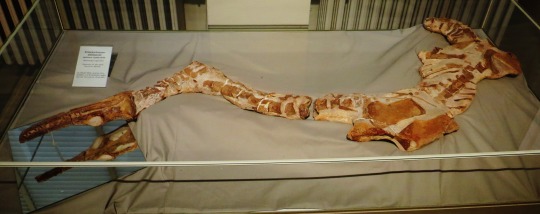
Photo by: Ghedoghedo, CC BY-SA 4.0
Name: Manemergus anguirostris
Name Meaning: Early/dawn diver
First Described: 2005
Described By: Buchy et al.,
Classification: Chordata, Tetrapoda, Reptilia, Sauropterygia, Plesiosauria, Polycotylidae
We have another polycotylid found from Africa, just like Thililua. Anyways, Manemergus was also discovered in the High Atlas Mountains in Morocco. Paleontologists recovered its skull, left femur, some of its phalanges, and some vertebrae.
Sources:
https://en.wikipedia.org/wiki/Manemergus
#Manemergus#palaeoblr#paleontology#palaeontology#prehistoric#Mesozoic#ancient marine reptiles#Not a dinosaur#sauropterygia
21 notes
·
View notes
Text
Malawania anachronus

Art by: Ghedoghedo, CC BY-SA 3.0
Name: Malawania anachronus
Name Meaning: Swimmer out of time
First Described: 2013
Described By: Fischer et al.,
Classification: Chordata, Tetrapoda, Reptilia, Ichthyosauria, Ichthyosauridae
Malawania is interesting, it’s a basal thunnosaur that lived during the Early Cretaceous of what is now known as Iraq. It was thought that basal thunnosaur ichthyosaurs were extinct by the Early Jurassic. The species name reflects this fascinating discovery as if Malawania was anachronistic in a way.
Sources:
https://en.wikipedia.org/wiki/Malawania
#Malawania#palaeoblr#Paleontology#palaeontology#prehistoric#Mesozoic#ancient marine reptiles#Not a dinosaur#ichthyopterygia
31 notes
·
View notes
Text
Makhaira rossica

Art by: Joschua Knüppe, https://www.deviantart.com/hyrotrioskjan/art/Makhaira-rossica-586349435
Name: Makhaira rossica
Name Meaning: Blade (Russian blade)
First Described: 2015
Described By: Fischer et al.,
Classification: Chordata, Tetrapoda, Reptilia, Sauropterygia, Plesiosauria, Pliosauridae
Makhaira wasn’t too big for a pliosaur, it was estimated to have been 16 feet (5 meters) in length. Even though it wasn’t very large for its size, Makhaira probably still hunted big prey. It’s distinctive teeth infer that it may have been a generalist and consumed whatever it could take down. This pliosaurid was discovered in Russia near the Volga River and dates all the way back to the Early Cretaceous.
Sources:
https://en.wikipedia.org/wiki/Makhaira_rossica
#Makhaira#palaeoblr#paleontology#palaeontology#prehistoric#Mesozoic#ancient marine reptiles#Not a dinosaur#sauropterygia
16 notes
·
View notes
Text
Maiaspondylus lindoei
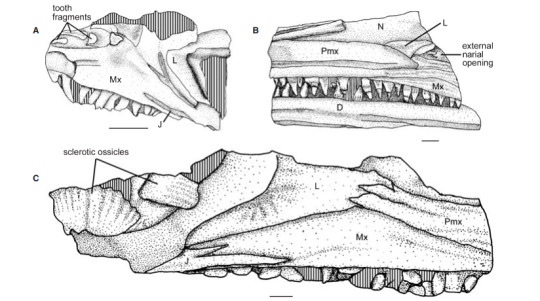
By: Maxwell and Caldwell, 2006
Name: Maiaspondylus lindoei
Name Meaning: Caring mother vertebra
First Described: 2006
Described By: Maxwell and Caldwell
Classification: Chordata, Tetrapoda, Reptilia, Ichthyosauria, Ophthalmosauridae, Platypterygiinae
Maiaspondylus was once thought to be Platypterygius, but that’s not the case because a recent study has shown that the two genera are indeed separate. Maiaspondylus swam the Early Cretaceous seas of what is now known as the Northwest Territories of Canada. One specimen was discovered with embryos inside of it. This is once again another example that supports that ichthyosaurs gave birth to live young.
Sources:
https://en.wikipedia.org/wiki/Maiaspondylus
#Maiaspondylus#palaeoblr#paleontology#palaeontology#prehistoric#Mesozoic#Not a dinosaur#ichthyopterygia
16 notes
·
View notes
Text
Macgowania janiceps

Art by: Amber, https://www.deviantart.com/transpaleoartist/art/You-were-an-Isle-unto-Thyself-796315508
Name: Macgowania janiceps
First Described: 1999
Described By: Motani
Classification: Chordata, Tetrapoda, Reptilia, Ichthyosauria, Parvipelvia
Paleontologists recovered a fairly complete skull and partial skeletal remains of Macgowania from Canada’s Pardonet Formation. This ichthyosaur was thought to be just another species of Ichthyosaurus, but Motani reexamined the holotype specimen and determined it to be a distinct genus on its own. Macgowania existed during the Late Triassic.
Sources:
https://en.wikipedia.org/wiki/Macgowania
#Macgowania#palaeoblr#paleontology#palaeontology#prehistoric#Mesozoic#ancient marine reptiles#Not a dinosaur#ichthyopterygia
45 notes
·
View notes
Text
Luskhan itilensis
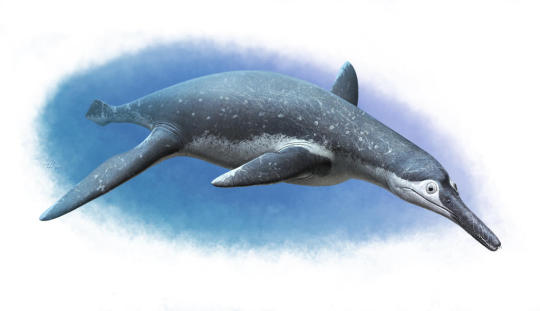
Art by: Andrey Atuchin, https://www.deviantart.com/olorotitan/art/Luskhan-itilensis-682594743
Name: Luskhan itilensis
Name Meaning: Water spirit chief
First Described: 2017
Described By: Fischer et al.,
Classification: Chordata, Tetrapoda, Reptilia, Sauropterygia, Plesiosauria, Pliosauridae, Thalassophonea
Luskhan was discovered in Russia and it lived during the Early Cretaceous. It was an unique pliosaur, as it had characteristics seen in both basal and advanced pliosaurs. Its narrow and slender snout along with it’s tiny teeth infer that Luskhan most likely hunted primarily fish and other soft prey items. We most likely would not see Luskhan trying to take down big prey.
Sources:
https://en.wikipedia.org/wiki/Luskhan
#Luskhan#palaeoblr#paleontology#palaeontology#prehistoric#Mesozoic#ancient marine reptiles#Not a dinosaur#sauropterygia
32 notes
·
View notes
Text
Libonectes morgani
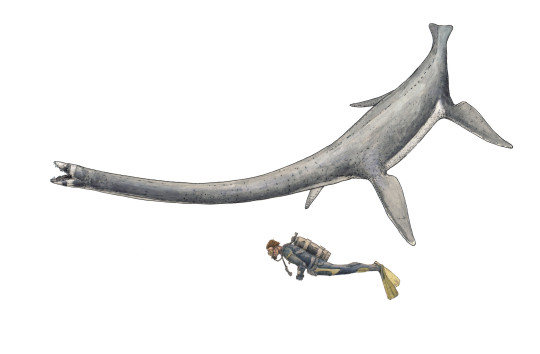
Art by: Joschua Knüppe
Name: Libonectes morgani
Name Meaning: Southwest swimmer
First Described: 1997
Described By: Carpenter
Classification: Chordata, Tetrapoda, Reptilia, Sauropterygia, Plesiosauria, Elasmosauridae
Libonectes was an elasmosaurid from the Late Cretaceous. This plesiosaur was discovered in Texas’ Britton Formation and also Morocco’s Akrabou Formation. The skull of the type specimen is actually extremely well preserved. In addition, not too surprising, gastroliths were also found with the elasmosaurid. As you know by now, many plesiosaurs have been discovered fossilized with gastrolith contents. Libonectes differ from Thalassomedon due to the former having much higher neural spines in its 16.6 feet (5.06 meters) long neck. Libonectes was once thought to be a species of Elasmosaurus, but was later realized to be a new and separate genus.
Sources:
https://en.wikipedia.org/wiki/Libonectes
#Libonectes#palaeoblr#paleontology#palaeontology#prehistoric#Mesozoic#ancient marine reptiles#Not a dinosaur#sauropterygia
43 notes
·
View notes
Text
Leptocleidus capensis, L. clemai, L. superstes

Art by: Mark Witton
Name: Leptocleidus capensis, L. clemai, L. superstes
Name Meaning: Slender clavicle
First Described: 1992
Described By: Andrews
Classification: Chordata, Tetrapoda, Reptilia, Sauropterygia, Plesiosauria, Leptocleididae
Leptocleidus was an Early Cretaceous pliosaurid plesiosaur, which gives its name to the controversial family called Leptocleididae because of the similarities seen in both pliosaurs and plesiosaurs. What’s really fascinating about Leptocleidus was that it dwelled in fresh water and brackish (water with some salinity, but not enough salinity to officially call it seawater) environments. It is currently hypothesized that Leptocleidus and even other members in the Leptocleididae family that lived in freshwater ecosystems such as Vectocleidus and Hastanectes, may have used fresh water systems as a way to avoid predation and even competition with other much larger pliosaurs and plesiosaurs.
Sources:
https://en.wikipedia.org/wiki/Leptocleidus
#Leptocleidus#palaeoblr#Paleontology#palaeontology#prehistoric#Mesozoic#ancient marine reptiles#Not a dinosaur#sauropterygia
30 notes
·
View notes